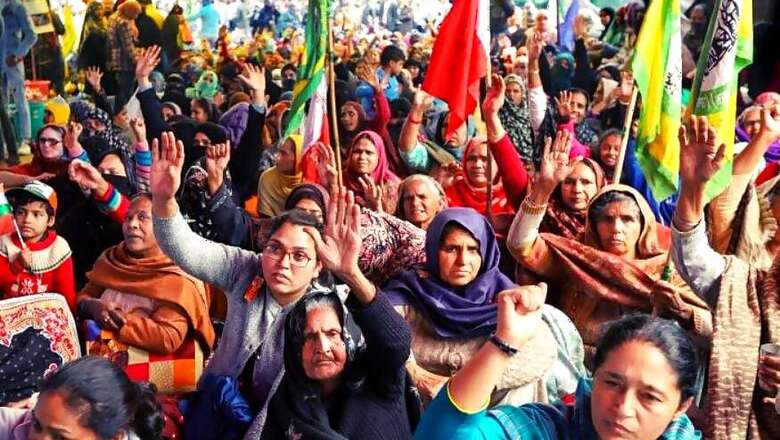
views
The International Women’s Day is an occasion to ponder over the impact of Shaheen Bagh and many such protests in other big and small places like Aligarh, Allahabad and Lucknow. We desire not to evaluate political outcomes of the anti-CAA protests. We don’t even intend to have a patronising attitude towards the protesting women by merely appreciating their efforts. What we are interested in is the potential of change in the consciousness of the country and society about gender realities through the efforts of the protesting (Muslim) women.
Never before in India, Muslim women came out in large number to protest for their rights: whether constitutional or related to personal laws.
After the Supreme Court delivered its verdict in the Shah Bano case, directing that she receive maintenance under the religion-neutral Section 125 of the Code of Criminal Procedure, the country witnessed ‘all male agitations’ opposing the apex court’s decision.
Muslim women, to a great extent, did not find platforms to explore their right to resist. There are only few occasions when they crossed the boundaries sanctioned by religion to agitate.
Some protests were organised against attempts of NDA-II government to criminalise triple talaq in which participation of women was not substantial, even though the issue was directly related to them. However, participation of Muslim women in the anti-CAA agitation is unparalleled in the history of India and therefore, it requires a serious study into the social outcomes of these protests.
The world over, there are numerous instances where women led the movements from the front. In South India, there was a movement that called for covering the upper part of the female body. Women of so-called lower castes were not allowed to cover their breasts. The immoral, irrational and inhuman practice was successfully spearheaded by women.
Whether it is Cairo’s Tahrir Square protests, which led to the resignation of Egyptian President Hosni Mubarak or the anti-nuclear power plant protests in Kudankulam in Tamil Nadu or the Narmada Bachao Movement, women were the major force who brought these movements to fruition.
Universities in India also saw frequent protests by students for their right to accessible public education, better hostel facilities and safety of students on the campus. The Banaras Hindu University (BHU) has had all-women students’ protests over law and order problems in the university.
Aligarh Muslim University (AMU) also witnessed protests by women students demanding better facilities in hostels and library. These protests yielded results as the administration brought positive changes in the way universities are administered.
Now, as far as anti-CAA protests are concerned, women emerged as the fulcrum. The huge participation of Muslim women is not only surprising but also intriguing, given the fact that most of them have never come out of the confines of their homes. Through these protests they seem to reclaim the public spaces to register their fight for equal citizenship rights.
The Shaheen Bagh phenomenon has been analysed in terms of political outcomes and as a celebration of the coming out of Muslim women by many. However, we are interested to analyse the protest in terms of its sociological outcomes and to measure its potential to realign society in terms of justice (including gender justice).
At the political level, what it has achieved is discernible to all. Analysing it through a sociological angle will give us an idea as to whether it has changed consciousness among women vis-a-vis gender issues.
Feedback from regular visitors to protests and their interactions with women at Shaheen Bagh in Delhi, and demonstration sites in Aligarh and Lucknow threw up some interesting conclusions.
When asked about the schedule of the women protesters, most of them answered that they join the protest in the evening after completing their domestic chores. They carry out the protest in shifts but maximum strength of numbers is at night.
At the end of the day when people unwind in the comfort of their homes, the women who have taken upon themselves the responsibility of resistance are also paving the way for a culture of “doing discomfort”.
Asked if men in the family share domestic responsibilities, the feedback was that they rarely cooperate in cleaning, cooking or washing chores but they do accompany women to the protests for safety purposes. So, in a way women have had to bear double responsibility- at home and at the protest site.
However, few women also observed that male members of the family do look after the children at home while they are at protest site. So, men in a way are taking care of children at home while their wives are out for the protest.
This seems to indicate that patriarchal structures are intact but women’s efforts and men’s accountability can give some hope and scope for a shift in consciousness. It’s because of these patriarchal values; women need to double up their efforts.
Observing and reading the protests closely, one thing that can be said for sure is that these women-led protests are creating the sense of camaraderie in them. Women are protecting each other, sharing their experiences with each other and also grasping many other values of a dignified and democratic life.
The language and the nature of protest, too, have undergone change. Women present there said these protests are more democratic, peaceful and disciplined as compared to the protests led solely by men.
These protests were first initiated as reaction to violence unleashed by police on Jamia students. Women came out in large numbers to protest as they believed that if men would have gone out and protested, they would have met the same fate as that of the students. So, as a protective shield, women started agitating to thwart the atrocities of the police on Jamia students.
Meanwhile, the Dadis of Shaheen Bagh led the ‘all women’ protest. The protesting women asserted that the nature and language of the protest have changed due to the overwhelming presence of womenfolk. Through the experiences of these women, a conclusion can be drawn that women become sufficiently trained in terms of political language and behaviour if they participate in protests in huge numbers, even when these demonstrations may not be directly related to women’s issues.
Since these women are now better equipped with language and methods of dissent and presenting their point of view in more nuanced ways, they may be ready to reassert themselves against the unequal ecosystem existing in their abodes. It would be interesting to see the impacts these ‘changing women’ would produce to create an equal society.
Anti-CAA protests may die down but their impact on the social lives of women would be felt in the times to come. They have learnt the new language. They have become more articulate. Women in the past have shifted the consciousness, they would do it again. They might use this training to wage struggles for equal space within the social, political and cultural structures. It is the responsibility of the society to acknowledge and align itself according to many outcomes these acts of dissent might bring about.
Tarushikha Sarvesh is an Assistant Professor of Sociology, Advanced Centre for Women’s Studies, Aligarh Muslim University and Abdul Hafiz Gandhi is an Assistant Professor of Law at Unity PG Degree and Law College, Lucknow. Views are personal.




















Comments
0 comment